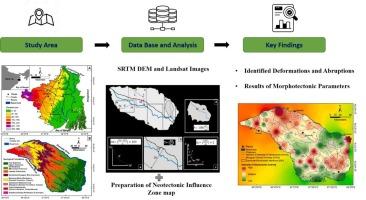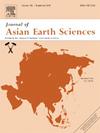Quaternary morphology and geodynamics of the Damodar-Kanshabati interfluve (DKI), India
IF 2.4
3区 地球科学
Q2 GEOSCIENCES, MULTIDISCIPLINARY
引用次数: 0
Abstract
The current study uses geo-morphotectonic analysis to understand and interpret the influences of neotectonics in the drainage network of the Damodar-Kanshabati interfluve in the Quaternary Period. The three objectives of this study are: i) identification, mapping and assessment of morphology of the DKI, ii) examination of the role of neotectonic deformations on drainage morpho-dynamics, iii) evaluation of the Quaternary structures and geomorpho-dynamics of the DKI. Topographic sheets, satellite images and field photographs were analysed to fulfill the objectives of the study. Morphometric, morphotectonic and geomorphic parameters had been analysed that reflect neotectonic activities in the interfluve. Identified deformed landforms, tilting, local uplift & subsidence and sudden changes at knick points in longitudinal profiles of all major rivers indicate a strong neotectonic influence in the interfluve. Abrupt changes in channel flow, sudden flow diversion, channel shifting reverse to surface slope and different sinuosity index values exhibit local tectonic deformations. Besides, lineament distribution & density index and earthquake history reflects neotectonic sensitivity of the interfluve. The analysis of morphotectonic parameters exhibit regional as well as local tectonic ambiguity across all physiographic zones. Hypsometric and basin asymmetry analysis based on second order streams and basins indicate small scale tectonic sensitivity across the interfluve. T-index results indicate tectonic deformations and significant neo-tectonism in different pockets. Bouguer gravity anomaly distribution and neotectonics influence zone map show various geomorphological surfaces with different levels of neotectonic activity. The study thus concludes that neotectonic controls have impacted the development of drainage networks in the Damodar-Kanshabati interfluve (DKI).

印度达莫达-坎沙巴蒂断裂带第四纪形态与地球动力学
利用大地-形态-构造分析来认识和解释第四纪新构造运动对达摩达尔—坎沙巴斯断裂带水系的影响。本研究的三个目标是:1)识别、制图和评价DKI的形态;2)检查新构造变形对流域形态动力学的作用;3)评价DKI的第四纪构造和地貌动力学。分析了地形图、卫星图像和实地照片,以实现研究的目标。分析了反映该断裂带新构造活动的地貌、构造和地貌参数。在所有主要河流的纵向剖面上,已确定的变形地貌、倾斜、局部隆起和沉降以及断裂处的突然变化表明,该断裂带受到了强烈的新构造影响。河道水流的突变、水流的突然改道、河道向地表坡度反向移动以及不同的弯度指数值均表现出局部构造变形。此外,剖面分布、密度指数和地震史反映了该夹层的新构造敏感性。形态构造参数分析表现出区域和局部构造的模糊性。基于二级流和盆地的等差和盆地不对称分析表明,跨间带的构造敏感性较小。t -指数结果表明,不同构造带存在构造变形和明显的新构造活动。布格重力异常分布和新构造影响带图显示了不同程度新构造活动的不同地貌面。新构造控制作用影响了达摩达尔—坎沙巴斯断裂带水系的发育。
本文章由计算机程序翻译,如有差异,请以英文原文为准。
求助全文
约1分钟内获得全文
求助全文
来源期刊

Journal of Asian Earth Sciences
地学-地球科学综合
CiteScore
5.90
自引率
10.00%
发文量
324
审稿时长
71 days
期刊介绍:
Journal of Asian Earth Sciences has an open access mirror journal Journal of Asian Earth Sciences: X, sharing the same aims and scope, editorial team, submission system and rigorous peer review.
The Journal of Asian Earth Sciences is an international interdisciplinary journal devoted to all aspects of research related to the solid Earth Sciences of Asia. The Journal publishes high quality, peer-reviewed scientific papers on the regional geology, tectonics, geochemistry and geophysics of Asia. It will be devoted primarily to research papers but short communications relating to new developments of broad interest, reviews and book reviews will also be included. Papers must have international appeal and should present work of more than local significance.
The scope includes deep processes of the Asian continent and its adjacent oceans; seismology and earthquakes; orogeny, magmatism, metamorphism and volcanism; growth, deformation and destruction of the Asian crust; crust-mantle interaction; evolution of life (early life, biostratigraphy, biogeography and mass-extinction); fluids, fluxes and reservoirs of mineral and energy resources; surface processes (weathering, erosion, transport and deposition of sediments) and resulting geomorphology; and the response of the Earth to global climate change as viewed within the Asian continent and surrounding oceans.
 求助内容:
求助内容: 应助结果提醒方式:
应助结果提醒方式:


